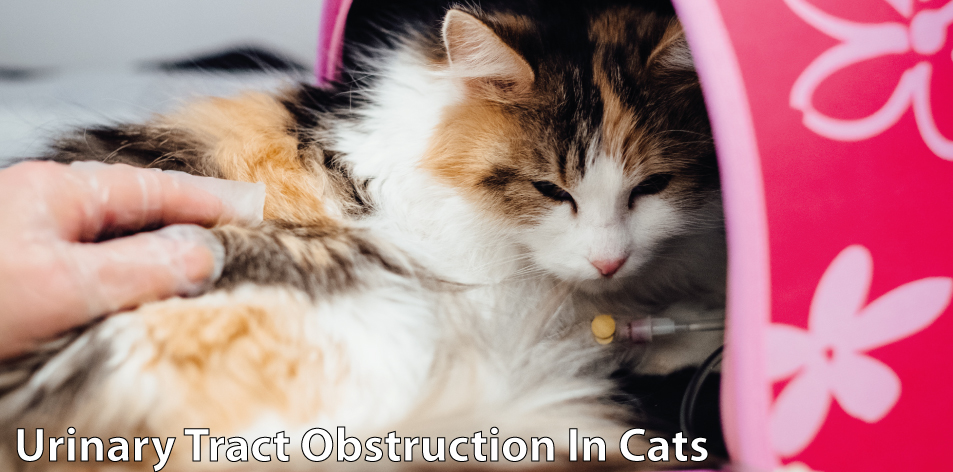
Your Guide To Urinary Tract Obstruction – by Dr. Desmond
What Is Urinary Tract Obstruction? – Written by Dr. Desmond
Urinary tract obstruction is a lethal condition that can take away your loved one in 2-6 days. It’s more common in males than females. Obstruction occurs in the urethra which is the duct that drains urine from the bladder through the penis to the outside.
The Obstruction Is Caused By:
• Inflammatory cells
• Mucus
• Crystals
• Calculi (small stones formed in the kidneys and passed down to the bladder)
The cause of the inflammatory materials and the stones is not fully understood but viral infections and diet top the list of causes. Other less common causes are cancers, trauma, and previous injuries causing scarring.
How Do You Know Your Cat Has An Obstruction?
The condition is common in ages ranging from 1-10 years. The cat will show discomfort while trying to pee, i.e. painful and straining to urinate, frequent urination, blood in the urine, urination in inappropriate places e.g outside the litter box.
These symptoms may subside or fully resolve in 5-7 days, but will recur in 6-12 months.
If the cat is completely blocked, they’ll try to pee but no urine will come out. The owner will notice frequent attempts to pee but nothing is coming out. They’ll raise a complaint of a cat trying to pee everywhere. The cat will be restless and will hide away. They soon become inappetent and very lethargic. The bladder becomes bigger and hard and can be felt in the posterior half of the abdomen even by massaging the belly unless it ruptures.
With complete obstruction, the cat will die if not attended in 3-6 days. Sometimes even with treatment the cat still passes on if diagnosed late.
Risk Factors:
• Dry food
• Being kept indoors
• Fearful, nervous, and aggressive behavior
• Stress
• Crowded cattery/housing with too many cats.
The incidence is higher in colder months. Inflammation in the bladder causes mucous plug also knows as Feline Urologic Syndrome “FUS” and is common in males compared to females. Congenital outpouching of the bladder “vesicourachal diverticuli” increases the risks of bladder infection. These may also be a result of chronic inflammation.
Diagnosis:
Once you notice these symptoms, you must contact your vet immediately as the condition is an emergency.
At The Vet:
• Diagnostic imaging, X-ray, and ultrasonography to visualize the bladder and urethra to check for crystals, stones, and structural changes on the bladder wall and thickening of the urethra causing a blockage. A contrast media May be infused into the bladder for proper visualization.
• Blood work to check for kidney function and proof of infection or systemic disease.
• Urine sample to evaluate the presence of crystals and a sample may be submitted for culture and sensitivity if a bacterial infection is suspected.
Treatment:
• The case MUST BE treated as an emergency.
• Sedation or General Anesthesia will be administered.
• A catheter is used to push the stones back into the bladder and to release urine. The bladder is then thoroughly flushed and drained through the catheter to remove any remaining crystals. The catheter may be left indwelling until the inflammation reduces and the cat can urinate freely. Pain medication will be prescribed, a diet change to reduce the formation of crystals, and other drugs that will make the cat relax and be comfortable.
• Cats with bigger crystals causing complete obstruction are flushed and a surgery, “cystotomy” (surgical opening of the bladder) is performed to remove crystals.
Cats that have recurrence even after surgery may have an additional surgery to widen the urethra. This is known as perineal urethrostomy. This is a permanent procedure that creates an opening that allows the crystals, mucus plug, and small stones to pass through the urethra and prevent future obstruction.
Patient Aftercare:
•Pellet of paper litter may be used for several days.
• if urine is leaking, an indwelling catheter will be left in place for 2-3days.
• An Elizabethan collar is put to avoid self-mutilation.
• Your vet will advise on checkups at regular intervals after surgery.
• Antibiotics may be prescribed or changed when necessary.
• Prevention of urethral blockage depends on the etiology. If surgery is performed properly, it’s highly unlikely that the condition will recur. Perineal urethrostomy does not prevent bladder inflammation or stone formation, however, so clinical signs of urinary tract disease may continue in some cats.
*Reference: https://www.acvs.org/small-animal/urinary-obstruction-cats Urinary Tract Obstruction
Dr. Desmond Tutu – B.V.M. – Veterinarian
If there is anything you would like to know, leave a comment and Dr. Desmond will get back to you!


